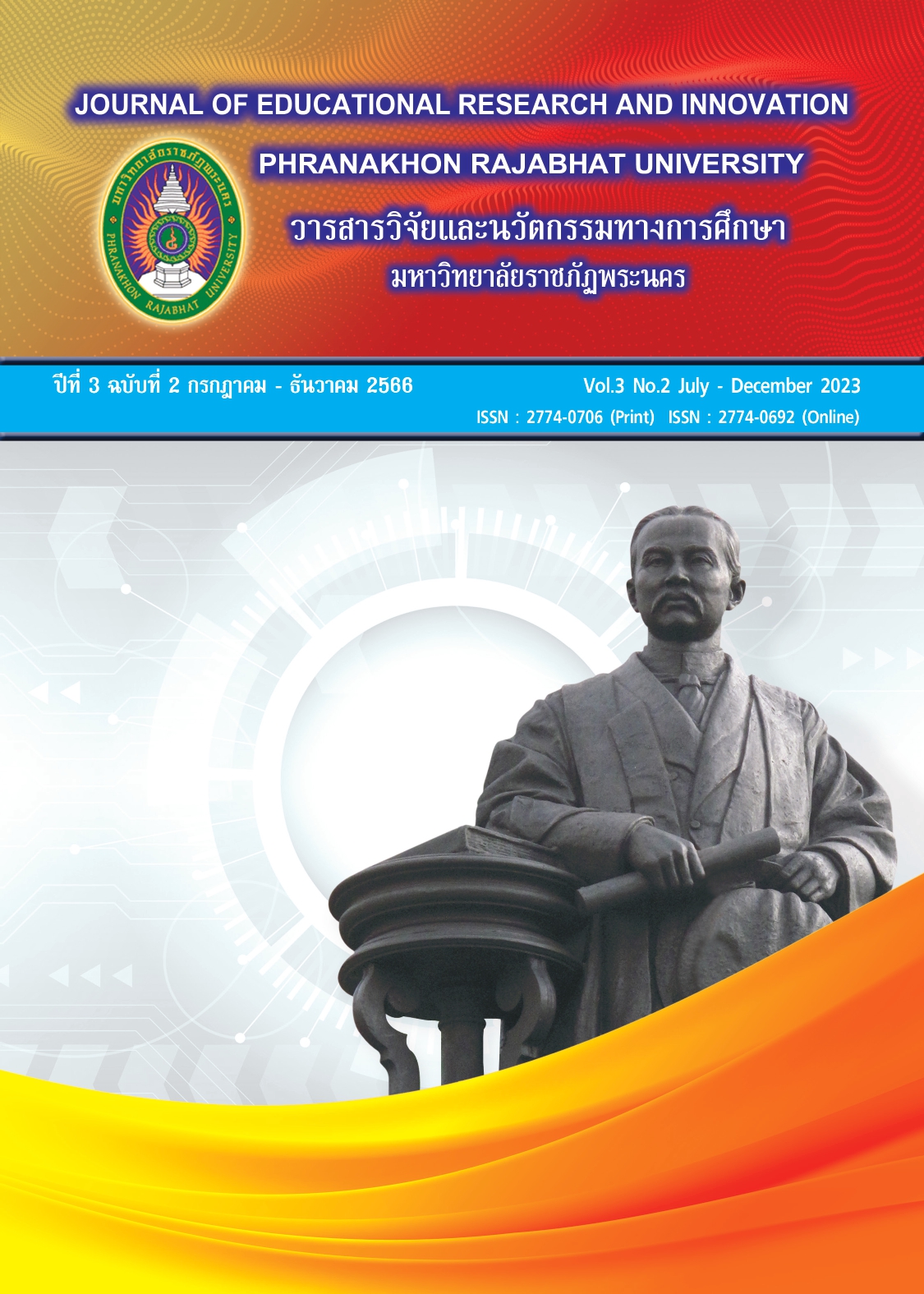THE DEVELOPMENT OF THE ABILITY TO CHANDA POETRY COMPOSING OF MATTHAYOMSUEKSA 6 WITH THE 5 STEPS LEARNING PROCESS WITH EXERCISES
Main Article Content
Abstract
The purposes of this research were to 1) develop Chanda poetry composing exercises of matthayomsueksa 6 students according to criteria 80/80 2) compare Chanda poetry composing ability of matthayomsueksa 6 students before and after using the 5-step learning process (5 STEPs) with exercises 3) study students’ opinions towards the 5-step learning process (5 STEPs) with exercises. The sample was 37 matthayomsueksa 6/10 which was selected by purposive sampling selection. The instruments used for this experiment were 1) lesson plans, 2) Chanda poetry composing exercises, 3) a test of Chanda poetry composing ability, and 4) a questionnaire on the students’ opinions towards the 5-step learning process (5 STEPs) with exercises. The data were analyzed the mean, the standard deviation, t-test dependent samples and content analysis.
The research results were as follows: 1) the effectiveness of the exercises was 81.04/90.74. This means that the exercises were at the acceptable level. 2) Chanda poetry composing ability of matthayomsueksa 6 students after using the 5-step learning process (5 STEPs) were significantly higher than before using the 5-step learning process (5 STEPs) at the .05 level. 3. The students’ opinions towards the 5-step learning process (5 STEPs) with exercises were generally at the highest level.
Article Details
References
Changkwanyuen, P. (1996). Text Book Written and Production Techniques.
Bangkok: Chulalongkorn University.
Dechakup, P., & Yindeesuk, P. (2015). Learning Management in 21st
Century. Bangkok: Chulalongkorn University Printing (In Thai).
Duangrawa, C. (2017). “The Development of Learning Activity Using 5 Steps Learning Process on the Topic of Philosophy of Sufficiency Economy, Social studies, Religion and Culture Department, Grade 4”. Thesis. Rajabhat Maha Sarakham University.
Jindapol, C. (1982). The Comparison of Noun Definition Understanding
and Remember Duration Using Picture Storytelling and Riddles of Prathomsueksa 1 students. Thesis. Srinakharinwirot University.
Loareandee, W. (2009). Techniques and Strategies in Thinking Skills, Child
Center Learning Management. Nakhonprathom: Silapakorn University.
Mahakhan, P. (1983). Principle of Thai Learning Management for Elementary
Level. Bangkok: The Printing House of the Teachers' Council.
Ministry of Education. (2008). Learning Standards and Indicators of Learning Area of
Thai Language, Basic Education Core Curriculum B.E. 2551 (A.D. 2008). Bangkok: Agricultural Cooperative of Thai Printing.
Manoonprucha, P. (2014). The Development of Klong Sie Suparp
Composing Tasks for Matthayomsuksa Sour Students. Master of Education Thesis Field of teaching: Thai language, Graduate School Silpakorn University.
Nillapun, M. (2010). Educational Research. 8th Edition. Nakhon Pathom: Silpakorn
Printing.
Ngammaen, J. (2010). The Development of Poetry and Kabyanee 11 Writing
Package for the Frist Year Vocational Certificate Students. Thesis. Silapakorn University.
Pantaweesak, S. (2018). The Development of Chanda Poetry Composing
Ability of Matthayomsueksa 5 Students using 4MAT Learning Management with Exercises. Master of Education Thesis Thai language teaching field Graduate School Silpakorn University.
Petchreung, W. (1988). The Comparison of Reading Ability of Grade 4 Students
Using Local Dialect between using Learning Package and Learning Package of Suntornwattana School.
Thesis, Master of Education Degree Primary education field Graduate School Sri University Nakharinwirot.
Peanchop, S., & Intrumpun, S. (1980). Thai Learning Management in
Matthayom Suksa. Bangkok. Thaiwattanapanitch.
Plubteang, S. (2008). Suggestion for Creating Learning Package. Retrieved from: http:// www.gotoknow.org/posts/203236. [2023, 25 Aug.]
Sripriwan, R. (1994). Teaching Poetry and Verse in Elementary Level,
Teaching Skills 1 (Thai Language). 4th Edition. Bangkok: Sukhothai Thammathirat Open University.
Srisayan, W., Inchai, S., & Suriyawong, B. (2020). The 5-Step Learning
Management Approach for Crtical Reading Skills Development in Thai Language Course of Matthayomsuksa 3 Bandaitepkanjanaubhatham School, Mae Sai District, Chaing Rai Provine. Ganesha Journal, 16(1), 69-80.
Sukkasem,T. (2018). The effects of 5 Steps Learning Process (5 steps) and
Analytical Questions in Evolution on Scientific Analytical Thinking and Achievement of Tenth Grade Students. CMU Journal of Education, 3(2), 24-36.
Sukkasem, A. (1981). Basic Knowledge of Thai Poem. Bangkok: Odeonstore.
Tripetch, S. (2015). 21st Century Skills and World – Class Standard School in
Satrisisuriyothai School. [Online]. Available: https:/sites.googlec.com.
Wongsubun, N. (2010). The Comparison of Klong Sie Suparp Poetry Composing
Learning Achievement of Matthayomsuksa 2 Using 4MAT Learning Management and the Conventional Method. Thesis. Silapakorn University.
Yonglan, P. (2014). The Resultsof UsingSkill Practice on Klon-Supap Writingin
Thai subject, Pratomsuksa 6, Wat Potaram School, Namom District, Songkhla Province. Thesis, Master of Education Degree Subject: Curriculum and Teaching Graduate School Hat Yai University.
Yingnok, P. (2021). The Study of Learning Achievement and Analytical
Thinking by Using the 5 Steps Learning Process with the Cooperative Learning Method STAD Technique on Geological Resources of 10th Grade Students. Master of Education Degree Thesis Department of Science Teaching, Burapha University.


